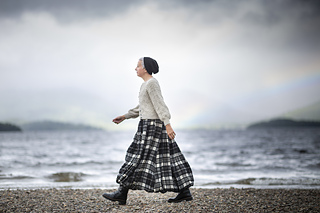During the course of poring greedily over the beautiful Bugga! colors, I was struck by gleeful, tickling, inspiration. I adore Kate’s original ever-so-adorable paper dolls, but am shy about embracing my girly side. I wanted my version to clearly and recognizably refer to hers, but also to veer wildly in a different direction.
I designed my fly to be exactly 2 times the width of a paperdoll. Due to the design difference, I had to do more decrease rows because there was room for only half the decreases in any given decrease row. I put a PDF of the fly for sale via ravelry: Housefly Chart. My chart does not include a rate of decreases -- you need to refer to Kate’s pattern or calculate your own.
The cast-on took me a couple days. The instructions for bind-off at the end of the i-cord cast-on did not work for me. Could be operator error. To accomplish it successfully, I referred to the instructions for the technique in the Fiddlehead Mitten pattern. I eliminated a set of increases and decreases during the waist shaping to keep it from being too long for me. I also eliminated the main decrease row at the top of the doll chart -- it cinched up the neck too quickly on me. I had to rip this section a couple times to get it right. I also ripped out the short rows a few times before going with wider, shallower short rows. I intended to try the Sunday short rows, but I didn’t understand the instructions. (I later figured out that this is because the instructions for resolving them are missing. I think that when Kate edited the pattern she put in part of the new instructions and left part of the old instructions -- so the two parts don’t match up. I subsequently learned how to resolve the short rows: when you get to the gap, you use the length of waste yarn you have placed there to pull a loop from the row below onto the left needle and knit it together with the next stitch.) I used the main decrease row from the chart as my final decrease row just before the neck ribbing.
This was a ridiculously expensive little top, what with all the fancy sock yarns. But I got so much giddy pleasure from the exquisite colors, so excited about the opportunity to do something stranded with a yarn that could not tolerate steeks, and so obsessed about realizing the vision in my head, that economy was trumped. The project photos do not do any justice to the yarn colors used.
The Skinny Bugga! is beautiful, dense stuff. Knits up beautifully. I carried the hank around with me for days, turning it this way and that. I put it on my desk where I could look up and admire it while I was working.
The color on the Tosh Sock is absolutely fantastic, and exceeded my expectations. After I got the one hank of maple leaf, I had to talk myself out of getting enough for a bodysuit. I only needed this color for a little speck on this sweater, so I have enough left to give it a starring role in some other project.
The Tosh Merino Light is a really pretty color, like slightly tarnished silver -- a silvery pale, pale grey with ever so faint green undertones. It is also very soft and, uh … light. It was a bit troublesome to wind because part of the hank was in a tangly mess.
I was not happy with The Loopy Ewe Solid Series yarn because of knots, but I WAS happy with The Loopy Ewe’s customer service! Sheri responded VERY graciously when I informed her of the problem, and is doing a quality control check on the black yarn.
Apparently, my brother pronounced the sweater “too weird for him.” Mom replied “It’s not too weird for your sister.” I say, “It’s not weird enough!”



57649 projects
stashed
56275 times
4735 projects
stashed
9499 times
135859 projects
stashed
149265 times
3041 projects
stashed
3488 times


 handspun
handspun queue
queue favorites
favorites friends
friends needles & hooks
needles & hooks library
library